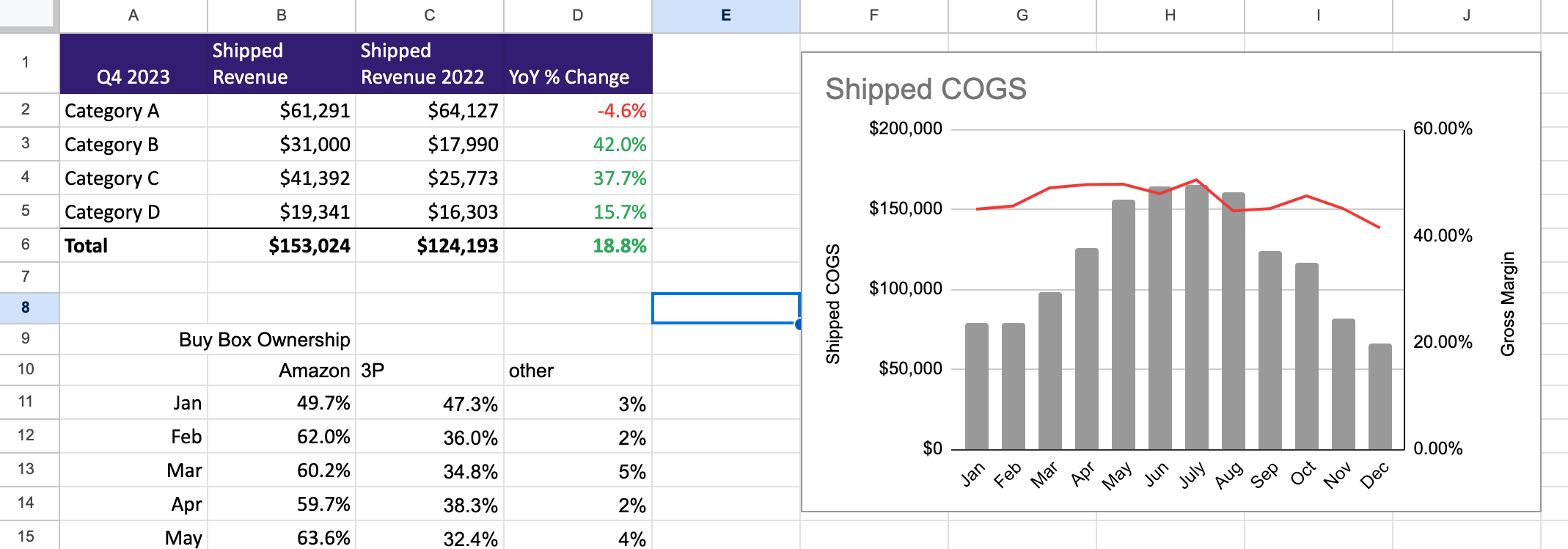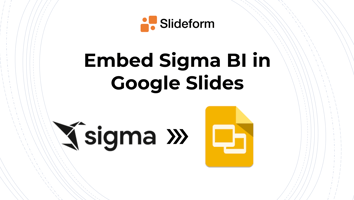Are you looking for a simple way to embed data from a cell in Google Sheets into a text box in...
Automatically generate Google Slides from Google Sheets with AI
5 simple steps to automating your Google Slides with AI
What is Slideform?
Slideform is an AI-enabled automation platform that links your business data to reports and slide decks. Upload a custom slide template or a previous report, and Slideform fills in the data. Use AI to create new charts or analysis, then insert it into the slides. Put your reports on autopilot with Slideform.
How is Slideform different from other AI slide tools?
Slideform's AI-powered report automation goes well beyond simply generating Google Slides. Using Slideform’s AI reporting engine, you can create and update recurring reports from a template. Analyze trends, summarize data, and create new charts directly from your Google Sheets data—and embed them into your Slides automatically.
What's the difference between Slideform and Google linked charts?
Slideform connects more than just charts to your Slides. Insert text, images, and other content from sheets to slides automatically. Slideform makes it easy to clone a report for a new client, so it scales with your business. The Slideform AI analyst can also add new calculations, charts, and dynamic summaries to your slides.
Slideform's AI-powered Google Sheets to Slides Automation
1. Connect a Google Sheet with data for the presentation
Slideform integrates with your Google workspace and many other datasources. You may already have a Google Sheet with data that you need to enter into your presentation. In this example, I am creating several sales reports for different clients and I have data for each client in a Google Sheet. See one of the sheets below:

The chart and the pre-formatted table (cells A1:D6) will be used in my slides.
To connect the Google Sheet to Slideform, just authorize your Google Workspace, then add the sheet as a new Data Source.
2. Connect a custom branded Google Slides template

- {{client_name}} - this text field will hold the client name
- {{month}} - this will have the month name
- {{image:client_logo}} - this is an image placeholder and it will be replaced by the client logo that I have stored in Google Drive
- {{fn:date}} - the date the slides are created
- {{revenue}} - the revenue in dollars for the month
- {{data:quarterly_revenue_by_cat}} - a small table of data showing revenue by product category
- {{chart:monthlyratings}} - a chart placeholder that will be filled by a chart from my Google Sheet
Save the template as a Google Slides presentation in your Google Drive workspace.
3. Use AI to analyze your data
New in 2025: AI-Powered Data Analysis for Google Sheets– Slideform goes beyond simple data transfer. Use natural language prompts to tell the Slideform AI analyst what to do, then import the results into your report. This saves hours of manual analysis and aids consistency across reports.
Slideform includes all the functionality you can find in Gemini for Sheets, but goes beyond the Sheet to deliver those insights, charts, and metrics directly into your Google Slides.
Slideform's AI analyst can automatically:
-
Analyze trends in your spreadsheet data (e.g. "What was the percent change in revenue for this month compared to the prior month?")
-
Generate plain-language summaries (e.g. “What was the gross margin for 2024?”)
-
Create new native Google Slides visuals like bar charts, pie charts, and tables (e.g. "Create a chart of revenue over time")
-
Highlight anomalies or outliers in your data (e.g. "Identify any seasonal trends in the data")
This means you’re not just building a slide deck—you’re creating a recurring report with dynamic insights.
The Slideform analyst uses a proprietary process to ensure reproducibility and reliability (no hallucinations!) of the analysis from one report to the next.
4. Match data to your slide template
The last configuration step is to connect the data to each placeholder pragma in the template. Create a New Project and select your Google Slide template from Google Drive.

Then, specify the data source and data value to use for each placeholder.
For example for the {{revenue}} text box, I want to pull the value from a specific cell in my Google Sheet. To do this, map the {{revenue}} pragma to cell "D26" in Slideform. The dollar sign and currency formatting can either be done in the spreadsheet or you can set the formatting in Slideform.

To pull in a chart or metric from the AI analyst, first add the Analyst as a Data Source for your project, then select the metric from the list of available data.
Slideform can do complex data filtering, lookups, and dynamic formatting too! For more information see: How to Configure the Data Mapping
You can embed charts, text, images, number, percents and more from more than one data source into the same Google Slides deck. Save the data configuration once all pragmas are set.
5. Generate the presentation
Now that my template and data are linked, I can generate the presentation whenever I need by clicking Generate.

Now for the fun part! Automate and schedule!
Let’s generate a presentation for each my clients. All I have to do is go to my form and click Generate. I choose the client’s name and click next and the slides are ready. No more copying and pasting!
If I have more reports to send out in the coming months, I can add those data to my sheet, go into Slideform, and generate the reports with one click. We can also schedule the reports to run automatically and send the results via email or Slack.
Want to supercharge your reporting workflows?
Try Slideform’s AI-powered Google Slides automation today. Start with a template, link your Sheet, and let our agent handle the rest—charts, text, insights, and all.
Want to see what Slideform can do for you?
Get full access to Slideform with a 30-day trial. No credit card required.



